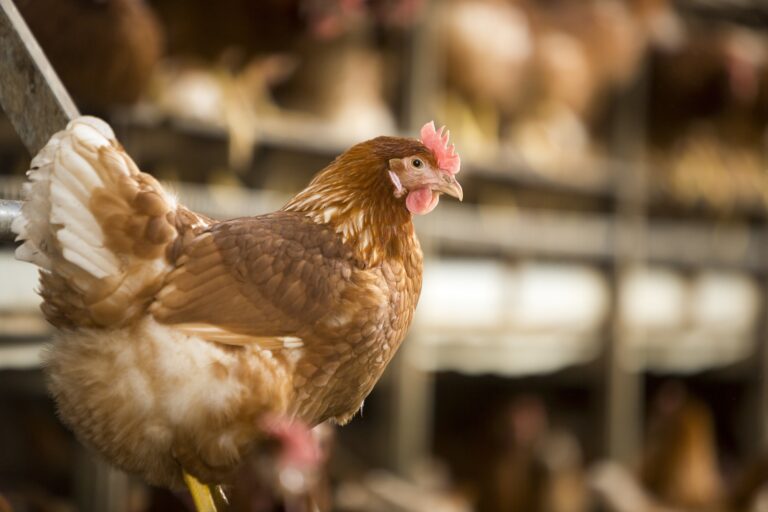A rounded approach to addressing the issue of poor eggshell quality could have significant benefits for layer production according to Chloe Paine, Poultry Technical Manager with Trouw Nutrition GB
This article first appeared in the Poultry Business feed & nutrition supplement, published in March 2022
“Poor eggshell quality remains a drain on profitability in layer units, affecting the saleability of eggs,” she says. “It is becoming a bigger issue as the length of the laying period has extended because as hens get older, shell quality drops. It is also a greater problem in the UK where the market is looking for larger eggs.
“In larger eggs the available calcium is spread thinner as there is only so much calcium to go round, meaning a larger shell will tend to be a thinner shell.”
Paine advises that it is possible to improve eggshell quality by paying close attention to the interrelated areas of nutrition, health and management.
She explains that eggshell is mineral rich, made up of calcium carbonate, phosphorus, magnesium, sodium, potassium, zinc, manganese, copper and iron. Some of these components can be mobilised from the hens’ bone, but all of them have to be supplied in the feed to ensure proper shell formation throughout the laying cycle.
“Research shows that supplementation with manganese, zinc and copper can improve shell characteristics, increase shell strength and reduce egg losses.”
She emphasises that it is important to supply trace elements in a highly bioavailable form, pointing out that different sources have different bioavailability meaning trace element absorption can be variable. This will affect the quantities in the diet that get absorbed into the bloodstream.
“The usual form of supplementation in layer diets is as inorganic salts such as sulphates and oxides but NRC 2001 reported that the absorption of inorganic trace elements is particularly low, often around 5-20% absorbed. Trials show that feeding trace elements in the more bioavailable hydroxy form results in better supply to the bird and significantly improved eggshell quality.”
Calcium remains the principle element in eggshell. Paine explains that during the laying period calcium is digested and absorbed from the feed into the blood stream and deposited in the medullary bone or used directly. The medullary bone is the major calcium reservoir in the bird, acting as a buffer between uptake from the feed during the day and deposition around the shell during the night.
“Young layers manage calcium metabolism more efficiently than older hens. Furthermore, egg weight increases with age coinciding with decreased calcium efficiency leading to thinner shells.
“Several studies concluded that increasing levels of calcium in the diets of older hens improved shell quality and reduced the incidence of broken shells. It is also possible to provide supplements that promote better absorption and metabolism of calcium.”
Paine also stresses the importance of gut health in efficient mineral absorption. She points out that gut health is crucial for feed efficiency and optimum mineral absorption. She comments that gut health is not age dependent and recommends the use of supplements such as Selko pH and Presan to prevent bacterial intake, support digestion, strengthen gut barrier function and stabilize microbiota which leads to improved gut health.
“In addition to ensuring the diet contains sufficient minerals in a bioavailable form and ensuring good gut health to drive absorption, it will also pay to modify feeding strategies, specifically considering split feeding.
“Split feeding is a feed strategy to closely meet the daily requirements of layers. Hens are fed two different diets per day to meet the differing requirements of the egg formation process. A morning diet will be higher protein to support egg formation while the afternoon diet will be higher in calcium, vitamin D3 and trace elements in particular to meet the hen’s requirements for eggshell formation.
“By more precisely matching requirements with supply of split feeding we can help reduce total intakes of energy, protein, calcium and phosphorus, improving sustainability by reducing excretions while reducing feed costs.
“In choice feeding trials we saw energy intakes reduced by 8%, crude protein by 11% and calcium intakes by 26%. This nutrient reduction is also what we see in split feeding application whilst both eggshell quality and lay persistency are also improved.
“As the industry continues to strive for longer lay periods, and as the market continues to prefer larger eggs, management of hens to reduce the incidence of, and costs associated with poor eggshell quality will remain a priority.
“There is no single silver bullet but a focus on nutrition, health and feeding management will help producers address the issue,” Paine concludes.


